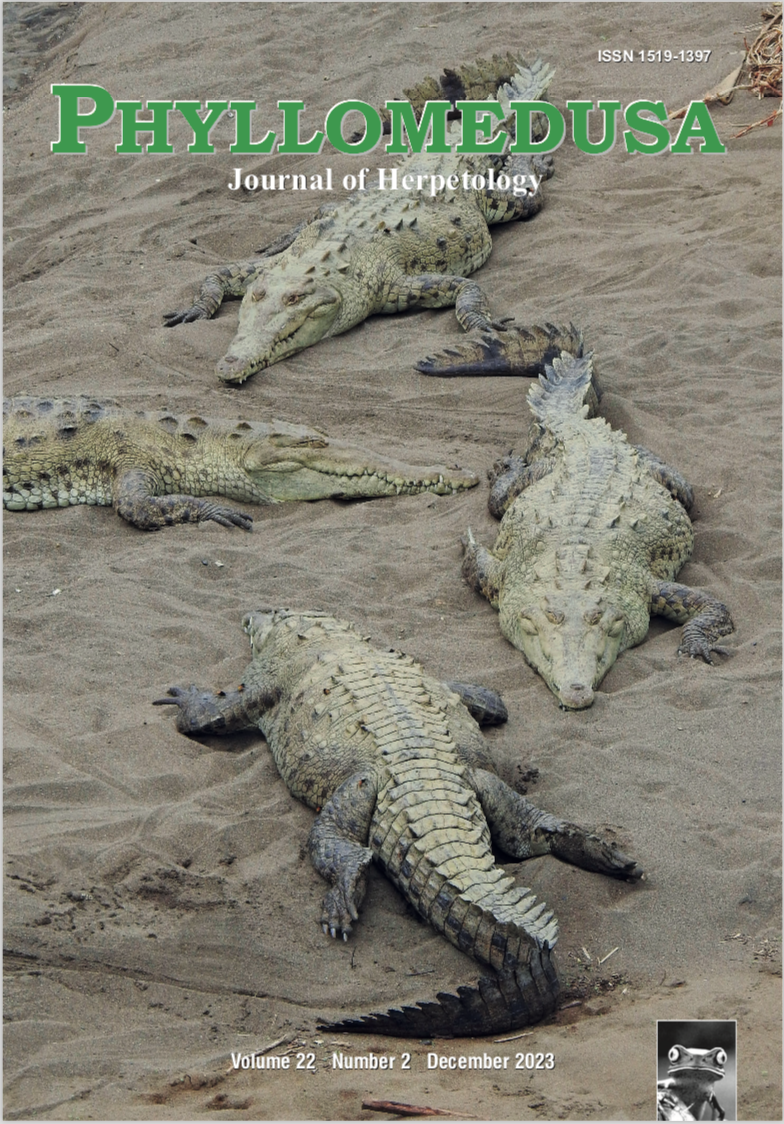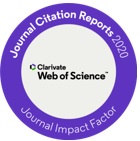Encontro casual na região central do Texas fornece informações sobre a ecologia da estivação de Siren nettingi (Caudata: Sirenidae)
DOI:
https://doi.org/10.11606/issn.2316-9079.v22i2p131-137Palavras-chave:
Anfíbios, Conservação, Dinâmica de habitat, Dormência, Estradas, PântanoResumo
Siren spp. costumam ser vertebrados dominantes nas áreas úmidas que ocupam e são conhecidas por estivar quando essas áreas úmidas secam. Considerações práticas limitam as observações in situ de indivíduos em estivação. Em 12 de outubro de 2021, descobrimos por acaso um agregado em estivação de Siren nettingi no condado de Bastrop, Texas, Estados Unidos. Essas salamandras foram escavadas em solo compacto e rochoso adjacente a uma estrada de caliche, em profundidades que variavam entre ~0,2 e 1,5 m. A vegetação dominante nesse local incluía Ulmus crassifolia, Persicaria sp. e várias espécies de gramíneas. Recuperamos 140 indivíduos, dos quais sete foram resgatados e 133 foram capturados vivos. Medimos 115 deles quanto ao comprimento rostro-cloacal (SVL) e observamos que o agregado era dominado por jovens. Estimamos uma densidade de estivação de 2,33 indivíduos/m2 que é comparável às densidades estimadas para populações sem estivação. No entanto, como não houve monitoramento para esse estudo, provavelmente tenha ocorrido um evento de mortalidade em massa. Portanto, sugerimos que a construção de estradas no habitat preferido seja considerada uma ameaça às populações dessas salamandras.
Downloads
Referências
Aresco, M. J. and M. S. Gunzburger. 2004. Efects of largescale sediment removal on herpetofauna in Florida wetlands. Journal of Herpetology 38: 275–279.
Bassett, L. G. 2023. Updated geographic distributions for Texas amphibians. Reptiles & Amphibians 30: e18486.
Bohannon, A. M. A., L. G. Bassett, F. E. Zughaiyir, S. Sirsi, A. Villamizar-Gomez, S. Bullard, and M. R. J. Forstner. 2022.
Geographic distribution. Siren intermedia (Lesser Siren). Herpetological Review 53: 69.
Cagle, F. R. and P. E. Smith. 1939. A winter aggregation of Siren intermedia and Triturus viridescens. Copeia 1939: 232–233.
Davis, W. B. and F. T. Knapp. 1953. Notes on the salamander Siren intermedia. Copeia 1953: 119–121.
Dixon, J. R. 2013. Amphibians and Reptiles of Texas, With Keys, Taxonomic Synopses, Bibliography, and Distribution Maps. 3rd Edition. College Station. Texas A&M University Press. 447 pp.
Fedler, M. T., K. M. Enge, and P. E. Moler. 2023. Unraveling Siren (Caudata: Sirenidae) systematics and description of a small, seepage specialist. Zootaxa 5258: 351–378.
Frese, P. W., A. Mathis, and R. Wilkinson. 2003. Population characteristics, growth, and spatial activity of Siren intermedia in an intensively managed wetland. Southwestern Naturalist 48: 534–542.
Gehlbach, F. R. and S. E. Kennedy. 1978. Population ecology of a highly productive aquatic salamander (Siren intermedia). Southwestern Naturalist 23: 423–430.
Gehlbach, F. R., R. Gordon, and J. B. Jordan. 1973. Aestivation of the Salamander, Siren intermedia. American Midland Naturalist 89: 455–463.
Goin, C. J. 1942. Description of a new race of Siren intermedia Le Conte. Annals of the Carnegie Museum 29: 211–217.
Graham, S., R. Kline, D. A. Steen, and C. Kelehear. 2018. Description of an extant salamander from the Gulf Coastal Plain of North America: the Reticulated Siren, Siren reticulata. PLoS ONE 13: e0207460.
Luhring, T. M. and R. M. Holdo. 2015. Trade-ofs between growth and maturation: the cost of reproduction for surviving environmental extremes. Oecologia 178: 723–732.
Luhring, T. M., G. M. Connette, and C. M. Schalk. 2016. Trap characteristics and species morphology explain size-biased sampling of two salamander species. Amphibia-Reptilia 37: 79–89.
Martof, B. S. 1973. Siren intermedia. Catalogue of American Amphibians and Reptiles 127: 1–3.
Martof, B. S. 1974. Sirenidae. Catalogue of American Amphibians and Reptiles 151: 1–2.
Petranka, J. W. 2010. Salamanders of the United States and Canada. Washington. Smithsonian Institution. 587 pp.
Powell, R., R. Conant, and J. T. Collins. 2016. Peterson Field Guide to Reptiles and Amphibians of Eastern and Central North America. New York. Houghton Mifin Harcourt. 494 pp.
Powell, R., J. T. Collins, and E. D. Hooper. 2019. Key to the Herpetofauna of the Continental United States and Canada. 3rd Edition. Lawrence. Kansas University Press. 184 pp.
Secor, S. M. and J. H. Lignot. 2010. Morphological plasticity of Vertebrate aestivation. Pp. 183–208 in C. A. Navas and J. Carvalho (eds.), Aestivation. Progress in Molecular and Subcellular Biology. Vol. 49. Berlin, Heidelberg. Springer.
Trauth, S. E., R. L. Cox, B. P. Butterfeld, D. A. Saugey, and W. E. Meshaka. 1990. Reproductive phenophases and clutch characteristics of selected Arkansas amphibians. Proceedings of the Arkansas Academy of Science 44: 107–113.
Downloads
Publicado
Edição
Seção
Licença
Copyright (c) 2023 ESALQ-USP

Este trabalho está licenciado sob uma licença Creative Commons Attribution-NonCommercial-NoDerivatives 4.0 International License.
All material originally published in Phyllomedusa belongs to Escola Superior de Agricultura Luiz de Queiroz - Universidade de São Paulo. All contents are under a license of Creative Commons BY-NC-ND.


 Impact Factor: 0.383
Impact Factor: 0.383  CiteScore: 0.7
CiteScore: 0.7